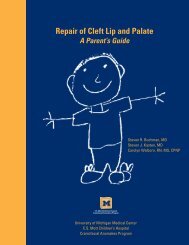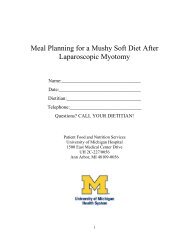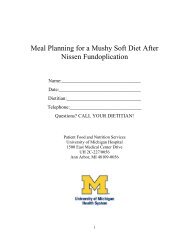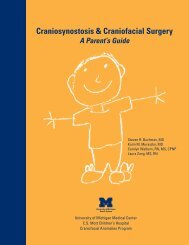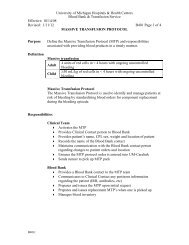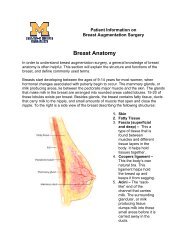R EED O. D INGMAN S OCIETY - Department of Surgery - University ...
R EED O. D INGMAN S OCIETY - Department of Surgery - University ...
R EED O. D INGMAN S OCIETY - Department of Surgery - University ...
You also want an ePaper? Increase the reach of your titles
YUMPU automatically turns print PDFs into web optimized ePapers that Google loves.
Options for reconstruction <strong>of</strong> peripheral nerve<br />
gaps are currently limited. In clinical practice,<br />
long nerve gaps following injury or tumor<br />
resection that cannot be repaired primarily are<br />
repaired with autologous nerve grafts. This<br />
procedure requires sacrifice <strong>of</strong> healthy nerves<br />
with permanent functional impairments. In<br />
some clinical situations, there may not be<br />
sufficient autologous nerve available for<br />
reconstruction <strong>of</strong> larger, more complex nerve<br />
defects. As a result, some investigators and<br />
clinicians have turned to peripheral nerve<br />
allografting as an alternative (MacKinnon<br />
1992). The main obstacle to widespread clinical<br />
use <strong>of</strong> peripheral nerve allografts however has<br />
been T cell mediated immune rejection<br />
(Ansselin 1990). Although potent<br />
immunosuppressive drugs are currently<br />
available to prevent graft rejection, they are<br />
associated with many toxicities. In addition,<br />
chronic global suppression <strong>of</strong> the immune<br />
system with these medications may result in<br />
opportunistic infections or secondary<br />
malignancies and their routine use in nerve<br />
allografting is not justified (Elster 2000).<br />
Therefore more selective immunomodulatory<br />
strategies to prevent graft rejection <strong>of</strong> peripheral<br />
nerve allografts such as induction <strong>of</strong> specific<br />
immune tolerance will need to be developed<br />
before this technique can be routinely used<br />
clinically.<br />
The CD40-CD40L co-stimulatory<br />
pathway has been shown to play a crucial role in<br />
allograft rejection. CD40 is a 50-kDa<br />
membrane glycoprotein found on a variety <strong>of</strong><br />
antigen-presenting cells (APCs) <strong>of</strong> grafted<br />
tissue. The ligand for this membrane receptor<br />
is CD40L, a 39-kDa glycoprotein that is<br />
preferentially expressed on activated CD4+ T<br />
helper cells <strong>of</strong> the recipient. The CD40-<br />
CD40L interaction mediates T cell immune<br />
responses by enhancing the co-stimulatory<br />
pathway which leads to rejection (Steurer<br />
2001). Manipulation <strong>of</strong> the CD40-CD40L<br />
co-stimulatory pathway may be beneficial in<br />
preventing allograft rejection. Indeed,<br />
T HE CD40-CD40L CO - STIMULATORY P ATHWAY<br />
IN P ERIPHERAL N ERVE A LLOGRAFT R EJECTION<br />
-Paul S Cederna, M.D., Anil K Mungara, M.D., Sherri Y Wood, Keith D Bishop, PhD.<br />
consistent with its central role in cell mediated<br />
immunity, blockade <strong>of</strong> CD40-CD40L by anti-<br />
CD40L monoclonal antibody (mAb) has been<br />
shown to prevent rejection <strong>of</strong> solid organ<br />
transplants such as cardiac and renal allografts<br />
(Kirk 1997, 1999,Larsen 1996,Kenyon 1999,<br />
Pierson 1999).<br />
Current thinking about the mechanisms<br />
leading to tissue rejection following<br />
transplantation revolve around T cell receptor<br />
(TCR) binding to genetically disparate major<br />
histocompatibility class II antigens (MHC II Ag)<br />
on APCs. The binding <strong>of</strong> the TCR to the<br />
MHC II antigen leads to release <strong>of</strong> cytokines<br />
from the T cell that lead to rejection <strong>of</strong> the<br />
grafted tissue. The most important cytokines<br />
released in this process are interferon gamma<br />
(INF- g) and interleukins (IL) 2, 4, and 5.<br />
INF- g and IL-2 are designated as TH1<br />
responses and mediate cellular rejection by<br />
activating macrophages as well as helper T and<br />
cytotoxic T cells. IL-4 and IL-5 are designated<br />
as TH2 responses and mediate humoral<br />
rejection by transforming B lymphocytes into<br />
plasma cells with subsequent antibody<br />
production.<br />
In addition to the MHC II Ag, APCs <strong>of</strong><br />
the transplanted tissue also express a molecule<br />
referred to as CD40 on their cell surface.<br />
When T cells encounter the foreign MHC II Ag<br />
<strong>of</strong> grafted tissue they become activated and<br />
produce the ligand for the CD40 molecule,<br />
referred to as CD40L on their cell surface.<br />
Interaction <strong>of</strong> CD40 with CD40L is essential<br />
for the TCR binding to the transplanted MHC<br />
II antigen. Without this CD40-CD40L costimulatory<br />
pathway, the T cell receptor cannot<br />
bind to the MHC II antigen <strong>of</strong> the grafted<br />
tissue, and cytokine production is inhibited,<br />
averting the cellular and humoral response<br />
cascades. This data has led many investigators to<br />
block this pathway using a monoclonal antibody<br />
directed against the CD40L molecule <strong>of</strong><br />
activated T cells in an attempt to induce<br />
tolerance to transplanted tissue. This approach<br />
has been shown to be highly effective in<br />
12 R E E D O . D I N G M A N S O C I E T Y<br />
preventing rejection in cardiac and renal<br />
transplantation models (Kirk 1997, Pierson<br />
1999). However, induction <strong>of</strong> tolerance to<br />
nerve allografts using this method has yet to be<br />
determined.<br />
In previous work from our laboratory, we<br />
have used sciatic nerve grafting between<br />
genetically disparate strains <strong>of</strong> mice such as<br />
BALB/c and C57BL/6 as a model <strong>of</strong> peripheral<br />
nerve allografting. Sciatic nerves from BALB/c<br />
donor mice are placed into a subcutaneous<br />
pocket in the back <strong>of</strong> recipient C57BL/6 mice.<br />
Following nerve grafting and post-op recovery,<br />
we harvest splenocytes and brachial lymph node<br />
cells and expose these cells to the alloantigens<br />
from the peripheral nerve graft donor.<br />
Cytokine production (INF- g, ILs-2, 4, and5)<br />
by these cells is then measured by the ELISPOT<br />
technique as a measure <strong>of</strong> cellular rejection.<br />
Humoral rejection is evaluated by measuring<br />
serum IgM and IgG levels by mean channel<br />
fluorescence. In this model, we have found that<br />
treatment <strong>of</strong> mice with a 3 day course <strong>of</strong> anti-<br />
CD40L mAb at the time <strong>of</strong> nerve allografting<br />
significantly reduces both T cell mediated TH1<br />
and TH2 responses as well as alloantibody<br />
production. The reduction in cytokine<br />
production is demonstrated in T cells isolated<br />
from the spleen as well as the draining lymph<br />
node basin. In addition, this hyporesponsiveness<br />
may be tissue specific as<br />
rechallenge with nerve allograft maintains an<br />
attenuated response while rechallenge with<br />
cardiac allografts results in a more dramatic<br />
response.<br />
In cardiac and renal allograft models, the<br />
reported timing and duration <strong>of</strong> the anti-<br />
CD40L mAb is quite variable. When<br />
treatment is delayed until 5 days after surgery<br />
in the mouse model <strong>of</strong> cardiac<br />
transplantation, no prolongation <strong>of</strong> graft<br />
survival has been observed (Larsen 1996).<br />
Because sensitization to nerve allografts occurs<br />
within the first several weeks following<br />
transplantation, coverage <strong>of</strong> the host with<br />
anti-CD40L mAb at least during this period



